 The EMC Data Domain DD2200 is a deduplication appliance for backup and archive data that is designed for small to midrange data centers. A recent addition to the Data Domain line, the DD2200 consolidates backup, archive, and disaster recovery into one easy-to-manage 2U rack unit platform. The device is offered in two configurations: either a 7 drive system with 7.5TB of usable space or a 12 drive system with 17.2TB of usable space. The DD2200 supports up to 4.7TB per hour throughput and can support up to 860TB of logical capacity via expansion shelves.
The EMC Data Domain DD2200 is a deduplication appliance for backup and archive data that is designed for small to midrange data centers. A recent addition to the Data Domain line, the DD2200 consolidates backup, archive, and disaster recovery into one easy-to-manage 2U rack unit platform. The device is offered in two configurations: either a 7 drive system with 7.5TB of usable space or a 12 drive system with 17.2TB of usable space. The DD2200 supports up to 4.7TB per hour throughput and can support up to 860TB of logical capacity via expansion shelves.
The EMC Data Domain DD2200 is a deduplication appliance for backup and archive data that is designed for small to midrange data centers. A recent addition to the Data Domain line, the DD2200 consolidates backup, archive, and disaster recovery into one easy-to-manage 2U rack unit platform. The device is offered in two configurations: either a 7 drive system with 7.5TB of usable space or a 12 drive system with 17.2TB of usable space. The DD2200 supports up to 4.7TB per hour throughput and can support up to 860TB of logical capacity via expansion shelves.
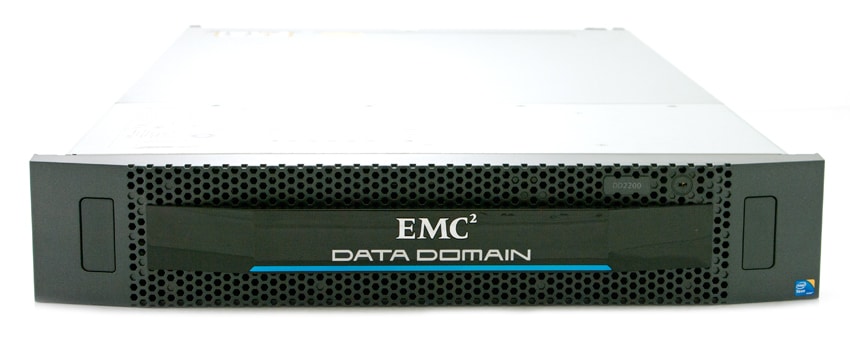
The EMC DD2200 includes Data Domain System Manager, and integrates with leading backup, archive, and enterprise applications. Wide application support is a key feature for Data Domain, customers may use EMC products like NetWorker for instance, or they may use offerings from VMware, Symantec, Veeam, CommVault and many others. Data Domain interfaces over Ethernet (CIFS or NFS) and Fibre Channel. FC connectivity brings with it VTL support and optional DD Boost. Data Domain systems also support replication for disaster recovery, sending only compressed changes over the wire. Other highlights include inline encryption of data at rest and secure retention for archive data, which satisfies compliance concerns.
Mentioned above, DD Boost is a big differentiator for Data Domain. Essentially, DD Boost integrates with key enterprise software packages, both backup and application, to streamline the backup process to improve performance. DD Boost works by distributing parts of the deduplication process to a backup server or application client so only unique data segments get sent to the Data Domain System. This results in up to 50% faster backups that use less bandwidth and system resources. DD Boost is available now for backup applications from EMC, Dell, Symantec, HP and VMware (Veeam will be supported in v8). On the enterprise application side, DD Boost supports IBM DB2, SQL Server, Oracle, Pivotal and SAP HANA.
The EMC Data Domain DD2200 system comes with a 1-year hardware only, limited warranty and starts at $20,000 (DD Boost licenses are not included). Our review configuration is with 12 drives and testing centers around the system configured for SQL Server backups with DD Boost.
EMC Data Domain DD2200 specifications:
- Maximum throughput: 3.5TB/hour
- Maximum throughput (DD Boost): 4.7TB/hour
- Logical capacity:
- Standard: 172TB
- Redundant: 860TB
- Max usable capacity: up to 17.2TB
- Drive type: SAS
- Built-in networking: 1 x Management port; 4 x 1GbE ports
- Optional networking with IO cards:
- Up to 8x 1GbE
- Up to 4x 10GbE
- Up to 8x 10GBase-T
- Up to 4x 8Gb FC
- Physical:
- Weight: 7 HDDs: 65 lbs./12 HDDs: 73 lbs.
- Dimensions (2U EIA rack units): 19″ x 29″ x 3.5″
- Environmental:
- Power:
- 100-120/200-240 V ~, 50/60 Hz
- 7 HDDs 406 VA
- 12 HDDs 502 VA
- Thermal Rating (Watts):
- 7 HDDs 394W
- 12 HDDs 487W
- Thermal Rating (BTU/hour):
- 7 HDDs 1,344
- 12 HDDs 1,662
- Operating Temperature/Altitude: 10°C to 35°C, 35°C at 7,500 feet
- Non-Operating (Transportation) Temperature: -40°C to +65°C (-40°F to +149°F)
- Operating Humidity: 20% to 80% non-condensing
- Operation Acoustic Noise (Sound Power): LWAd: 7.2 bels
- Operation Acoustic Noise (Sound Pressure): LpAm: 65 db
- Power:
Design and build
The EMC Data Domain DD2200 is a 2U rackmount appliance. Like many EMC products, the DD2200 offers a large front bezel, with prominent EMC branding, as well as slots for cooling air to be drawn through and a handy lock to prevent access to HDDs to the front of the unit. Underneath the front bezel are 12 3.5″ HDD bays, which in our unit is populated with 2TB drives. Each drive bay has its own drive power/status light, which shows which drives are powered up and if any has a problem to easily located it for replacement. Our DD2200 storage configuration consists of a RAID6 pool over 11 drives, with one drive left as a hot spare.

Going around to the back of the device, users can access the two power supplies on the right hand side. The bottom row of ports includes four 1GbE interfaces for LAN connectivity, a serial console port, USB as well as another management interface. Along the top row EMC includes multiple bays for expansion modules for different optional interfaces. Our configuration included two modules which offered dual 10GbE Twinax connections each. Optional modules include support for a wide range of network types including both Ethernet and Fibre Channel. The DD2200 also includes battery packs internally to protect data in the event of a power loss.

The view from inside the EMC Data Domain 2200 is very clean, and shows one high-end enterprise feature you generally don’t see in small or mid-market products. The backup battery seen in the middle of the photo near the side of the chassis provides enough power to safely commit all data stored in DRAM to disk and safely shutdown the system to prevent any data loss or array corruption.
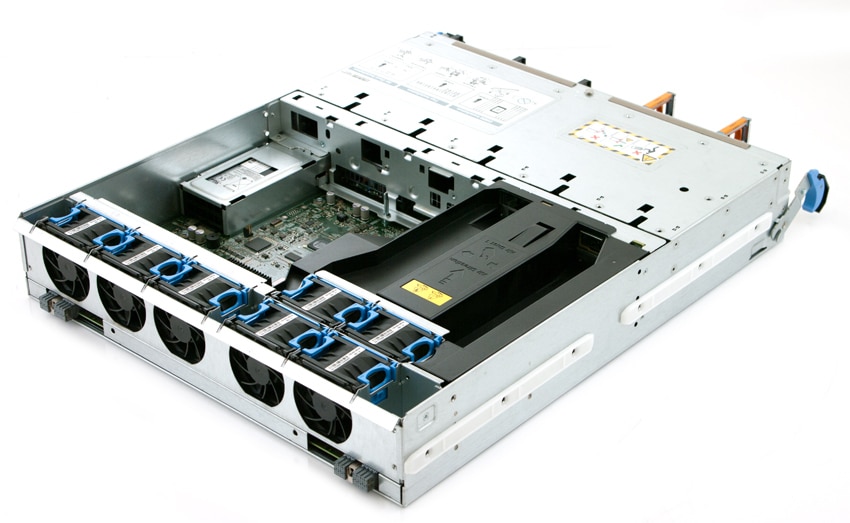
Usability
Data Domain System Manager is an easy-to-use web-based management system. A configuration wizard takes users through the initial setup and deployment. Once set up, users can monitor the DD2200 through the dashboard. Running along the side of the dashboard are a few tabs to monitor health, capacity, replication, reports, administration, and inventory.
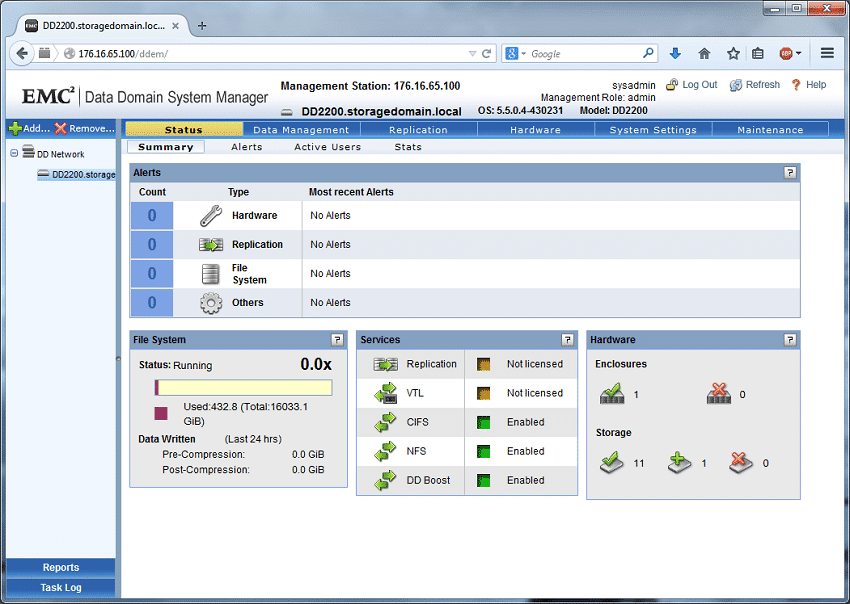
Once logged into the DD System Manager, users can find a wealth of information on their DD2200. For overall component health information, EMC provides a handy section that when you mouse over certain components you get a readout of current status, temperatures and other information. In the view shown, we see that the internal battery is at 100% charge.
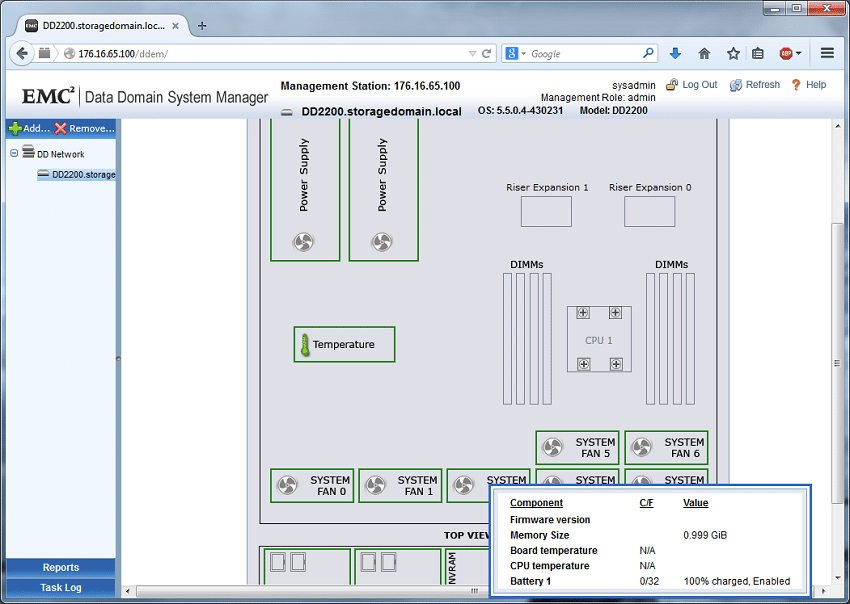
Drilling into the Data Management section users can view the total available capacity and what is currently used. After the course of an early testing session we see that out of 15.66TB usable we have consumed 0.42TB. Pre-compression that data would fill up 2.37TB, but the DD2200 has been able to provide a 5.6x data reduction factor to minimize the footprint of that particular backup group.
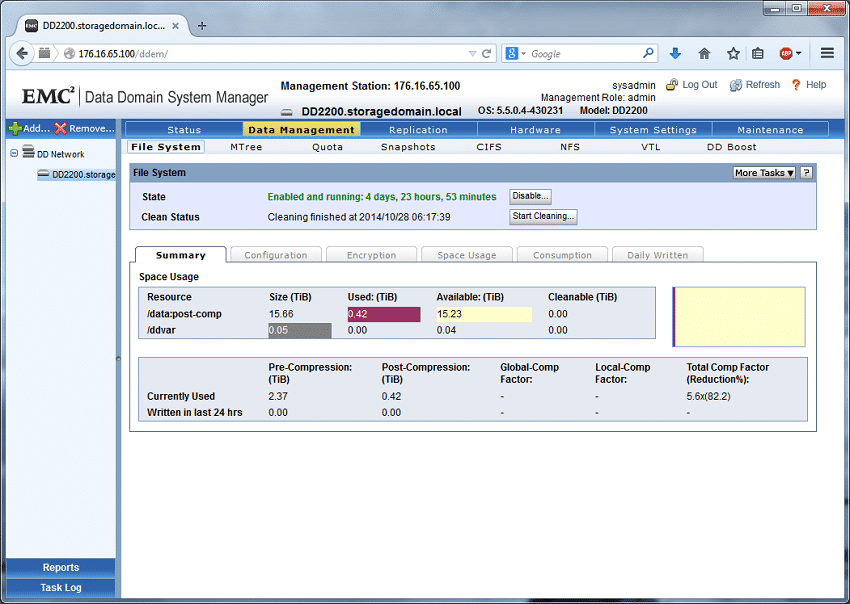
Inside Data Management you can create CIFS shares, pointing to locations inside the file system. This section is where you go when changing permissions on a given share, including which IP addresses are allowed to access it as well as different users.
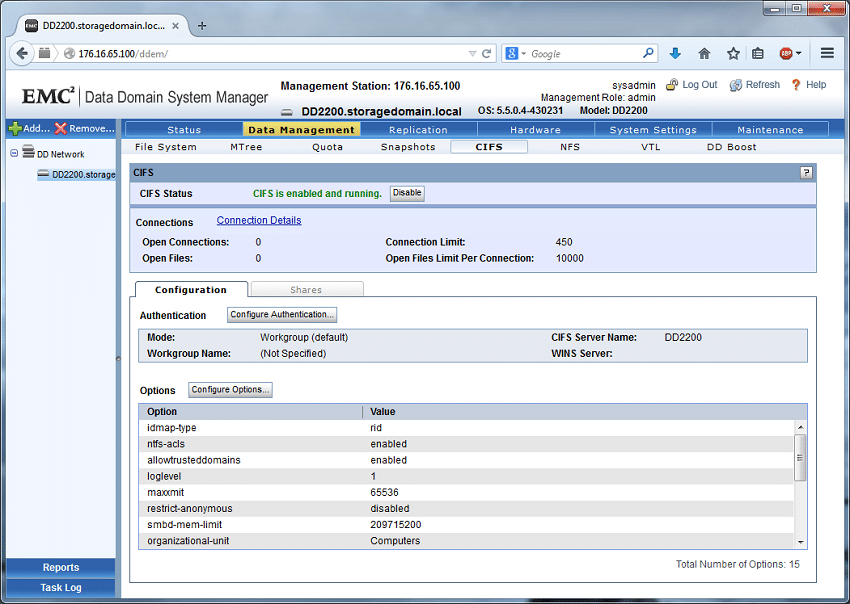
Similar to the CIFS management section, the DD Boost menu lets you set allowed clients, look at active users, setup different fabrics for access and a number of other items. For our testing we configured a single 10G Twinax port as an allowed access connection to our DD Boost backup storage.
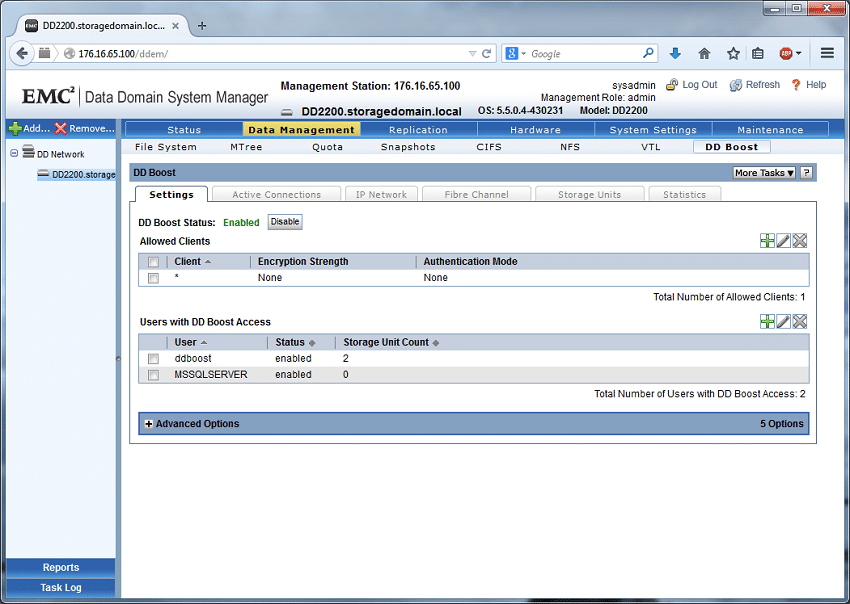
While it wouldn’t be used as frequently as other sections, the Hardware storage section allows you to view the status of the DD2200’s storage configuration. In this section we see our RAID6 storage pool using 11 disks, with 1 left over as a hot-spare.
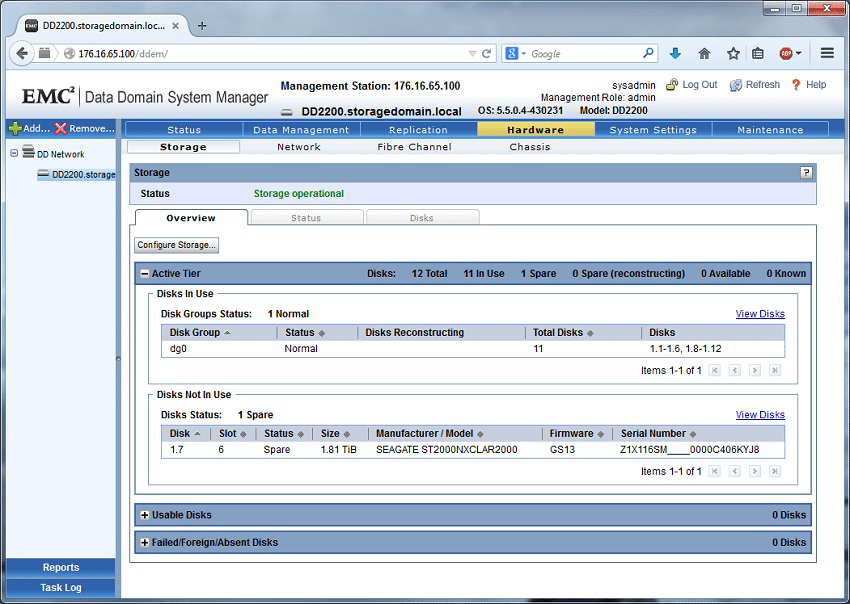
Performance
We publish an inventory of our lab environment, an overview of the lab’s networking capabilities, and other details about our testing protocols so that administrators and those responsible for equipment acquisition can fairly gauge the conditions under which we have achieved the published results. To maintain our independence, none of our reviews are paid for or managed by the manufacturer of equipment we are testing.
The DD2200 is being tested in our SQL Server 2012 environment, although unlike most of our performance tests that measure TPC-C performance, this one looks at backup performance while leveraging our benchmark to create change within a given database. For this side by side comparison, we use both SQL Server’s internal CIFS backup as well as with DD Boost for SQL. DD Boost for SQL, like other DD Boost implementations, does a few things. First, it offloads much of the data reduction process to the SQL Server from the Data Domain appliance. The core benefit is that since deltas are managed at the SQL level (and better than what SQL can do on its own), less data gets passed to the Data Domain. This means iterative backups are smaller and faster, leading to improved Data Domain speed and efficiency, while giving it more headroom to handle additional backup duties. The server-side reductions also decrease load on the network. DD Boost for SQL gives the application owner direct control of their backups to Data Domain. Configuration takes place in Microsoft SQL Server Management Studio, reducing reliance on the backup administrator if the organization has one.
DD Boost for Microsoft SQL supports both Ethernet IP and Fibre Channel, so it works well within a variety of environments. We tested the DD2200 leveraging SQL Server 2012, showing the benefits of DD Boost versus CIFS over both 10GbE and 1GbE. For our CIFS tests we used the native backup support built into SQL Server. In both configurations we used 4 streams to maximize the bandwidth across each interface. Each of the 1GbE and 10GbE test routines includes seven runs. The first is a full SQL back up job. Runs 2-4 are full backups with no changes to the database. The fifth run is a backup after the TPC-C benchmark runs, essentially causing wholesale changes to the underlying SQL database. The last runs again reflect no database changes.
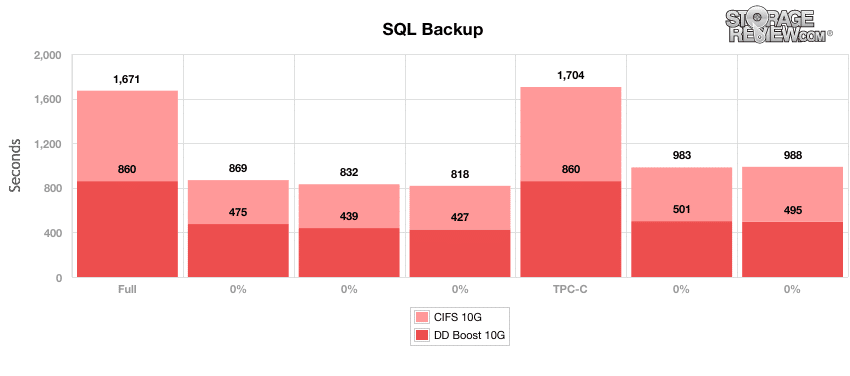
In the first test measuring CIFS vs. DD Boost over 10GbE, we see a dramatic decrease in the time for the first full backup leveraging DD Boost over SQL Server’s native backup scheme. This advantage stays at roughly 2x the for the duration of the test intervals.
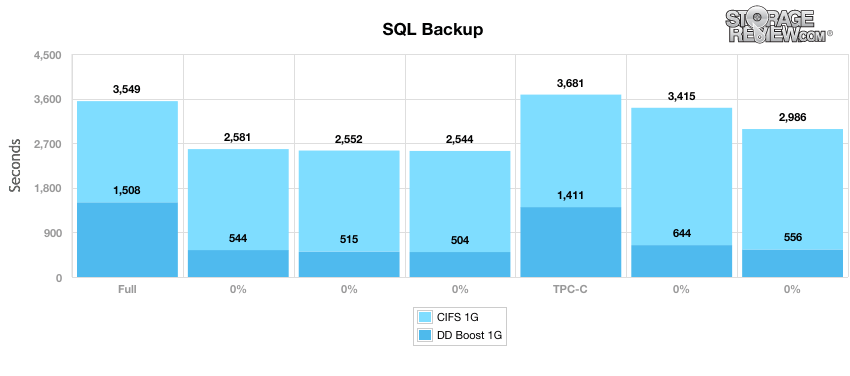
Comparing CIFS vs. DD Boost over 1GbE the difference is much more profound, where host-side deduplication has an enormous benefit. With lower bandwidth being the primary bottleneck, DD Boost for SQL Server is able to finish 2.35x quicker over standard CIFS in the first full backup. In the next interval moving to no change rate, the DD Boost is able to finish 4.74x quicker with a backup window of 9 minutes compared to 43 minutes over CIFS. During both backups the 1GbE network interface was completely saturated. Of course this impact scales as backup size increases, meaning a backup administrator can shorten the backup window while also freeing bandwidth for other purposes.
Conclusion
The EMC Data Domain DD2200 is a highly capable backup storage system with compression and deduplication features targeting small to midrange data centers. While the maximum usable capacities run from 7.5TB for the 7-drive and 17.2TB for the 12-drive systems, the DD2200 can scale up to address up to 860TB of logical space post compression/dedupe. A key selling point with Data Domain are the software integrations like Data Domain Boost, which leverages host-side deduplication to shrink backup windows and lower network bandwidth consumed.
In our tests we positioned the DD2200 as a backup appliance in our Microsoft SQL Server 2012 environment. Measuring the performance of SQL Server’s native backup performance over CIFS, we compared that to the DD2200 with DD Boost package installed. Our test consisted of timing seven full backup runs to see how the DD2200 performed with and without Boost over 1GbE and 10GbE fabrics. The net result is that we saw a dramatic difference using DD Boost bringing a 2x backup decrease over our 10GbE network and a 4x decrease over our 1GbE network. The benefits, especially in the 1GbE environment, cannot be understated. The SQL backups were essentially saturating the network in the case if the 1GbE testing, meaning anything else trying to occur on that network at the same time would suffer. DD Boost dramatically reduced the network load making the backup window shorter, but also freeing up infrastructure resources for other work.
On its own the DD2200 gives EMC channel partners a great little dedupe appliance to put to work in smaller customer environments or as part of ROBO environments where the enterprise may want replication to the home office. EMC is also wisely bundling the DD2200 with their updated VNXe3200, which addresses primary storage needs for the same audience. Between the two, a small operation can get an impressive amount of performance and data security features in just a few rack U.
Pros
- DD Boost offers huge backup window gains in 1GbE and 10GbE environments
- Complete enterprise feature set brought down to the midmarket
- Great plugin to larger DD environments for ROBO
- DD Boost for SQL easy to implement
Cons
- Scale up architecture means new head unit if backup demands grow faster than expected
Bottom Line
The EMC Data Domain DD2200 is a 2U deduplication appliance aimed at small to midrange data centers. In our testing with DD Boost For SQL, the results were very impressive especially in environments constrained to a 1GbE fabric. We saw a 4x improvement in backups across 1GbE, dramatically shortening the backup window while also relieving infrastructure stress.
